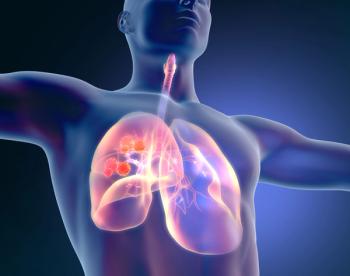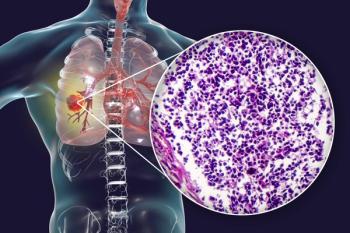
Oncology NEWS International
- Oncology NEWS International Vol 19 No 6
- Volume 19
- Issue 6
Personalized medicine advances in non-small–cell lung cancer treatment
Success of adaptive randomization in BATTLE could provide new strategy in cancer trials. NSCLC also gain another tool for maintenance therapy.
ABSTRACT: Success of adaptive randomization in BATTLE could provide new strategy in cancer trials. NSCLC also gain another tool for maintenance therapy.
The treatment armamentarium for nonsmall- cell lung cancer has received fresh ammunition in the past few months with FDA approval of erlotinib (Tarceva) for maintenance therapy (see News Briefs) and positive preliminary results from a trial that looked at the value of biomarkers in NSCLC.
While the BATTLE trial confirmed the vital role biomarkers play in designing NSCLC treatment, the study also offered proof that adaptive randomization-pairing patients with the therapies that offered them the best chances-was workable. BATTLE leaders suggested that the experience demonstrated a new way to approach and conduct all cancer clinical trials.
microRNA serves as potential target for lung cancer therapy
Knocking down microRNA-31 production suppressed lung cancer growth in an animal study conducted at the National Cancer Institute, leading the investigators to suggest that microRNA-31 may be a key oncomir in lung cancer.
Xi Liu, PhD
, a postdoctoral fellow at the NCI, said that, based on his research, microRNA-31 was overexpressed in malignant lung tissue when compared with normal tissue. In his animal model study, knocking down microRNA-31 production suppressed lung cancer growth. Also, expression of miR-31 was inversely related to LATS2 and PPP2R2A in both mouse and human lung cancers. "We hypothesize that microRNA-31 is a target to repress for lung cancer therapy and prevention," he said. (AACR 2010 abstract 5698).
"This trial has shown us that we can learn as we go," said Edward S. Kim, MD, an associate professor of thoracic/head and neck medical oncology at Houston's M.D. Anderson Cancer Center and the principle investigator of the BATTLE trial. "We decided that instead of running the same studies over and over again, adding new drugs to old drugs and hoping for a benefit, we had to stop looking at the drugs and start looking at the patients."
In the BATTLE (Biomarker-integrated Approaches of Targeted Therapy for Lung Cancer Elimination: Personalizing Therapy for Lung Cancer) trials, biomarkers were pitted against different drugs. This technique of adaptive randomization allowed patients to be paired with the therapies most likely to benefit them.
"The purpose of BATTLE was to biopsy patients in real-time so we could determine their individual biomarkers," Dr. Kim said. The researchers enrolled patients with progressing lung cancer, performed biopsies, "and tried to figure out which therapies were best for them," he added.
Patients enrolled in the phase II study tested 11 biomarkers from four non-small–cell lung cancer (NSCLC) pathways:
Based on eligibility criteria and tumor biomarker analysis, subjects were adaptively randomized into the treatment arms (see
The 46% 8-week DC of patients who achieved eight-week disease control had a median overall survival of 11.3 months compared with 7.5 months for the patients who did not maintain eight-week disease control (P = .002).
Dr. Kim said BATTLE results thus far prove that such a complicated study can be accomplished, adding that the trial will continue to refine the use of adaptive randomization and may lead to better treatment options for lung cancer patients.
VANTAGE POINT
DEEPA SUBRAMANIAM, MD Making strides in personalized NSCLC therapy
Oncologists have hit a ceiling with the current crop of chemotherapeutic agents for NSCLC, said Dr. Subramaniam, an interim-chief of thoracic oncology at Georgetown University Hospital in Washington, DC.
Dr. Subramaniam said the discovery of mutations in certain key genes in lung cancer, and the drugs that target these subsets of cancer mutations, "have made great strides in improving the prognosis for patients with lung cancer."
"If we are going to make significant progress in the care of lung cancer patients, we need to identify the molecular basis of the cancer in specific subsets of patients and develop personalized or targeted therapies. That is the primary goal of the BATTLE trial," she added.
Articles in this issue
over 15 years ago
Nobel laureate heads up NCIover 15 years ago
Cleveland Clinic nets federal funds for research facility revampover 15 years ago
Diabetes drug acts as chemopreventive in smokersover 15 years ago
FTC extends deadline for Red Flags Rule on patient privacyover 15 years ago
Breakthrough cancer-related pain: The truth hurtsover 15 years ago
African-American genetic mutations pose Rx challengeover 15 years ago
PET unable to reliably identify post-Rx colon metsNewsletter
Stay up to date on recent advances in the multidisciplinary approach to cancer.



















































































